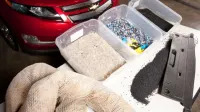Chevy Volt components to be built from Gulf of Mexico’s oil-soaked booms [w/video]

There’s really no way to positively spin the disaster that took place in the Gulf of Mexico when BP’s Deepwater Horizon drilling platform exploded and leaked untold millions of gallons of oil into the ocean. That said, it seems that General Motors has figured out a way to “creatively recycle” an estimated 100 miles of oil-soaked plastic boom material.
If not recycled, much of this material would likely have ended up in landfills, and we’d much rather see it reused under the hood of the 2011 Chevrolet Volt than buried under the ground to rot way over several lifetimes. Specifically, GM will mold radiator air deflectors from plastic that’s made up of 25 percent recycled boom material and 25 percent recycled tires, with the remaining 50 percent “a mixture of post-consumer recycled plastics and other polymers.”
Enough of the boom material has apparently been collected to fill GM’s needs for these plastic parts over the Volt’s entire first year of production, and it’s likely that these recycling efforts will continue to other models in the automaker’s portfolio. See the recycled boom material used in the Volt in our image gallery below, and check out a video along with the entire press release after the break.
The video meant to be presented here is no longer available. Sorry for the inconvenience.
PRESS RELEASE
Chevrolet Volt Components Created from Gulf of Mexico Oil-Soaked Booms
100,000 Pounds of Waste Saved from the Nation’s Landfills
2010-12-20
DETROIT – Oil-soaked plastic boom material used to soak up oil in the Gulf of Mexico is finding new life as auto parts in the Chevrolet Volt.
General Motors has developed a method to convert an estimated 100 miles of the material
off the Alabama and Louisiana coasts and keep it out of the nation’s landfills. The ongoing project is expected to create enough plastic under hood parts to supply the first year production of the extended-range electric vehicle.
“Creative recycling is one extension of GM’s overall strategy to reduce its environmental impact,” said Mike Robinson, GM vice president of Environment, Energy and Safety policy. “We reuse and recycle material by-products at our 76 landfill-free facilities every day. This is a good example of using this expertise and applying it to a greater magnitude.”
Recycling the booms will result in the production of more than 100,000 pounds of plastic resin for the vehicle components, eliminating an equal amount of waste that would otherwise have been incinerated or sent to landfills.
The parts, which deflect air around the vehicle’s radiator, are comprised of 25 percent boom material and 25 percent recycled tires from GM’s Milford Proving Ground vehicle test facility. The remaining is a mixture of post-consumer recycled plastics and other polymers.
GM worked with several partners throughout the recovery and development processes. Heritage Environmental managed the collection of boom material along the Louisiana coast. Mobile Fluid Recovery stepped in next, using a massive high-speed drum that spun the booms until dry and eliminated all the absorbed oil and wastewater. Lucent Polymers used its process to then manipulate the material into the physical state necessary for plastic die-mold production. Tier-one supplier, GDC Inc., used its patented EndurapreneTM material process to combine the resin with other plastic compounds to produce the components.
The work in the Gulf is expected to last at least two more months and GM will continue to assist suppliers in collecting booms until the need no longer exists. The automaker anticipates enough material will be gathered that it can be used as components in other Chevrolet models.
“This was purely a matter of helping out,” said John Bradburn, manager of GM’s waste-reduction efforts. “If sent to a landfill, these materials would have taken hundreds of years to begin to break down, and we didn’t want to see the spill further impact the environment. We knew we could identify a beneficial reuse of this material given our experience.”
The world’s first electric vehicle with extended range, the Chevy Volt was recently awarded Green Car of the Year by Green Car Journal.
GM is dedicated to reducing its waste and pollutants, and recycles materials at every state of the product lifecycle. It uses recycled and renewable materials in its cars and trucks, which are at least 85 percent recyclable. Used tires, old plastic bottles, denim and nylon carpet are all redirected from landfills and reused in select GM vehicles.
GM facilities worldwide recycle 90 percent of the waste they generate. The automaker recently announced more than half of its worldwide facilities are now landfill-free – all manufacturing waste is recycled or used to create energy.
About General Motors – General Motors Company (NYSE:GM, TSX: GMM), one of the world’s largest automakers, traces its roots back to 1908. With its global headquarters in Detroit, GM employs 209,000 people in every major region of the world and does business in more than 120 countries. GM and its strategic partners produce cars and trucks in 31 countries, and sell and service these vehicles through the following brands: Buick, Cadillac, Chevrolet, GMC, Daewoo, Holden, Isuzu, Jiefang, Opel, Vauxhall, and Wuling. GM’s largest national market is China, followed by the United States, Brazil, the United Kingdom, Germany, Canada, and Russia. GM’s OnStar subsidiary is the industry leader in vehicle safety, security and information services. General Motors acquired operations from General Motors Corporation on July 10, 2009, and references to prior periods in this and other press materials refer to operations of the old General Motors Corporation. More information on the new General Motors can be found at www.gm.com.




